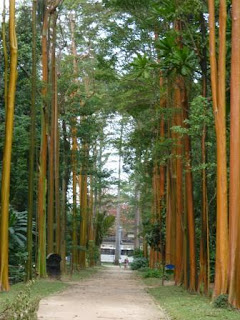There are so many places to visit in Rio de Janeiro that the Botanical Gardens often get overlooked, especially by those who don’t have such green fingers. Personally I would recommend it for just about any visitor to the city, and most would find it rewarding. The gardens can be visited in a couple of hours, and combined easily with some of the city’s more famous sights, or perhaps with the Sitio Burle Marx gardens further out of town. On a sultry summer day in Rio, the shade from the tall palms and other assorted trees is more than welcome.
The Botanical Gardens lie between the Rodrigo de Freitas Lagoon and the mountains of the Parque Nacional da Tijuca, which can always be seen through tree trunks and leaves while wandering around, including Corcovado with the statue of Christ the Redeemer almost directly above.
The gardens are now neighboured by the Jockey Club, making the whole area one of the least developed in the city. It was even less developed in 1808, when King João of Portugal decided to inaugurate the gardens, soon after arriving in Brazil to escape a potential revolution at home. The original idea was to have a place for spices to become accustomed to Brazil, as they had after being imported into the Caribbean, with nutmeg, cinnamon and pepper having successfully taken there following introduction from the Spice Islands of Indonesia. Strangely despite the success of the gardens, Brazil still seems to be the only Latin country in the world that doesn’t have black or white pepper on every table.
The gardens were opened to the public in 1822, the same year that João’s son Pedro had declared independence from his returned father’s kingdom. There are now over 6,000 tropical tree and plant species, with the 900 types of palm being possibly the most spectacular, including the centre-piece Avenue of Royal Palms, and the incredible colours of the Pau Mulatto trees This Amazon spruce sheds its bark completely between July and September, the bark being one of those used in Ayahuasca rituals, and the colours of the smooth trunk include bronze, green, orange and purple. The sight of the whole alley of pau mulattos in their annual Carnaval parade makes you wonder if you actually drank some ayahuasca before arriving at the gardens.
The other essential tree to look out for is the pau brasil. This is the tree that is responsible for the whole of Brazil. Or for the name at least. The Portuguese explorers found the tree with its red resin being useful for dyes. It grew in the Atlantic Rainforest from Rio de Janeiro up to Rio Grande do Norte, including most of the original areas that the colonialists went ashore. The Portuguese cut down this 15m tall tree in thousands and thousands, shipping them off for sale in Europe in order to pay off debts to the English government of the time. They were the original reason for colonisation, before the sugar and coffee plantations had even been considered.
The Rio de Janeiro Botanical Gardens also boasts an impressive Bromeliário and a colourful Orquidário, as well as houses for carnivorous and cacti plants, the Sensorial Garden, and also the Fountain of the Muses focal point. Waterfalls and trails through the Atlantic Rainforest keep the scenery interesting, while the local wildlife colours the trees and grasses, and would hold the attention of young children, at least for a while! The turtles climbing over each other to catch some sun at the entrance are supplemented by enormous carp in the ponds. Visits from monkeys are common, including the cute tuft-eared marmosets, and the less cute howler monkeys - renowned for their piercing grunts, and also for throwing their faeces at other creatures that invade their personal space.
Hundreds of bird species can be found too, including the vivid colours of parakeets, macaws, humming-birds (the more poetic beija-flor in Portuguese – the Flower-Kisser) and many different types of toucan. They are generally quite small compared to their Amazon and Pantanal cousins, but the yellow-breasted or black-beaked toucans, and the classical tucanuçu are numerous in the gardens, flying from tree to tree for berries. Sightings of these wonderful birds and others are far more common in the gardens than outside, as they have become accustomed to the presence of humans over the years, and do not fly off quite so readily as in the forests. Their habit of taking flight at regular intervals, just as you have your camera set on them amongst the foliage, only makes them even more loveable. Personally, I think the toucans are worth the bargain R$6 entrance fee on their own, even if the gardens themselves might not appeal.
They should though. The Rio de Janeiro Botanical Gardens are one of the most impressive in Brazil, South America or anywhere else, and should definitely be on the list of Things To Do in Brazil.







No comments:
Post a Comment